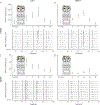Anodal Contralesional tDCS Enhances CST Excitability Bilaterally in an Adolescent with Hemiparetic Cerebral Palsy: A Brief Report
- PMID: 36967533
- PMCID: PMC10228174
- DOI: 10.1080/17518423.2023.2193626
Anodal Contralesional tDCS Enhances CST Excitability Bilaterally in an Adolescent with Hemiparetic Cerebral Palsy: A Brief Report
Abstract
Hemiparetic cerebral palsy (HCP), weakness on one side of the body typically caused by perinatal stroke, is characterized by lifelong motor impairments related to alterations in the corticospinal tract (CST). CST reorganization could be a useful biomarker to guide applications of neuromodulatory interventions, such as transcranial direct current stimulation (tDCS), to improve the effectiveness of rehabilitation therapies. We evaluated an adolescent with HCP and CST reorganization who demonstrated persistent heightened CST excitability in both upper limbs following anodal contralesional tDCS. The results support further investigation of targeted tDCS as an adjuvant therapy to traditional neurorehabilitation for upper limb function.
Keywords: Brain Excitability; Hemiparesis; Motor Evoked Potential; Perinatal Stroke; Transcranial Direct Current Stimulation.
Conflict of interest statement
Figures


References
MeSH terms
Grants and funding
LinkOut - more resources
Full Text Sources
Other Literature Sources
Medical
Miscellaneous
